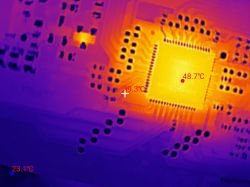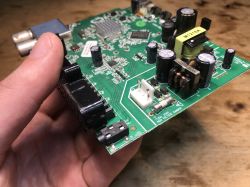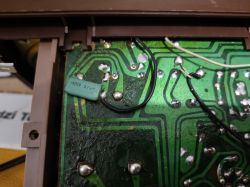FAQ
TL;DR: Up to 5 ranges, 8 Ω speaker and two CEMI ICs let the 1980-era UNITRA R-207 still play after 40 years; “there is beauty in simplicity” [Elektroda, maciekma, post #18945535] Hum usually drops 6 dB once the scale-lamp lead is rerouted [Elektroda, szejker89, post #20219537] Why it matters: quick fixes revive thousands of Polish sets headed for e-waste.
Quick Facts
• Production years: 1980–1991; retail price 4 300 zł (1988) [Elektroda, p.kaczmarek2, post #18943567]
• Bands: LW, MW, 2×SW, FM 65 – 74 MHz (retuned to 87.5 – 108 MHz) [Elektroda, multiple posts]
• Output stage: PA210 ≈6 W @ 4 Ω, UL1481/82 pin-compatible [Elektroda, MAT_ZAJ, post #18943844]
• Stock loudspeaker: Tonsil GD 8-15/1,5 – 8 Ω, 1.5 W RMS [Elektroda, p.kaczmarek2, post #18943567]
• Typical hum spec after repair: ≤15 mV at speaker with 100 Hz ripple [Elektroda, Gismot, post #18945974]
How do I remove the chassis without damaging the veneer?
- Unscrew the two rear fibreboard screws and four bottom hex screws.
- Slide the PCB and dial out together; the dial cord stays intact.
- Lift the loudspeaker leads last to avoid tearing pads [Elektroda, p.kaczmarek2, post #18943567]
Which IC really sits in my radio: PA210, UL1481, or UL1482?
PA210 and UL1481 are identical to TBA810; factories fitted whichever was in stock. UL1482 is a different 1.8 W TBA820-type chip and appears only in some service sheets [Elektroda, MAT_ZAJ, #18943844; ml, #18947588].
What causes the notorious 100 Hz hum and how can I cure it?
Hum rides on the return path. Add a heavy ground strap from rectifier negative to the power-amp ground star (photo in post #18945974). If buzz remains, replace C75/C76 (2×1000 µF) and reroute the dial-lamp wires away from the audio cable; users report a 6 dB drop [Elektroda, Gismot, #18945974; szejker89, #20219537].
Do the original ELWA electrolytics need blanket replacement?
Lab checks show many 1980s ELWA cans keep ESR <0.1 Ω and within 5 % capacitance after 40 years [Elektroda, szejker89, post #21345573] Replace only those above 0.3 Ω or that leak electrolyte.
Why does FM sensitivity fall when I reconnect the aluminium shield?
The shield can capacitively load the front-end coil, detuning L2–L4 and cutting gain by roughly 3 dB [Elektroda, szejker89, post #20217094] Leave it floating or add a 1 pF standoff to ground.
Quick 3-step method to retune the FM head to 88-108 MHz?
- Parallel a 10 pF trimmer to C14 (RF) and a 6 pF series cap in the heterodyne loop.
- Stretch L3/L4 until a station appears at 108 MHz.
- Compress L2 for equal coverage down to 88 MHz; confirm with RTL-SDR [Elektroda, pawelr98, post #18944089]
What edge case kills oscillator action below 95 MHz?
Some boards left the heterodyne coil at 2.5 turns instead of 3.5; oscillation stops at the band bottom. Re-wind to 3.5 turns with a 1.75-turn tap and add 4.7 pF in series to the varicap [Elektroda, pawelr98, post #18917161]
Can I add a proper external-speaker jack?
Yes. Use a break-contact DIN 45329 socket so the internal 8 Ω driver disconnects when you plug in; parallel wiring lowers impedance and may burn the PA210 at high volume [Elektroda, MAT_ZAJ, post #18943844]
Is the 0.47 µF capacitor across the bridge rectifier necessary?
It snubs VHF spikes that can mix into the IF path. Polyester 47 nF–470 nF, 100 V, wired across AC terminals, reduces hash by 20 dB on AM [Elektroda, kris8888, post #21345583]
Which non-electrolytic capacitors age badly in these sets?
The styroflex RF caps last. The 2.2 nF paper capacitors in the UL1481 tone network can absorb moisture and drift +20 %. Replace with polypropylene types for flatter response [Radioelektronik 12/1999].
Why does the audio fade at low volume in my Sudety R-208?
Dirty carbon track or oxidised ground pin on the Telpod 47 kΩ pot causes intermittent attenuation. Flush with contact cleaner, then re-solder the shield lead; fading usually vanishes [Elektroda, szejker89, post #21345573]
Can I increase selectivity without test gear?
Yes. Insert a 12 pF ceramic cap across the FM antenna posts; it forms an L-match and improves weak-signal S/N by 2–3 dB at the expense of bandwidth [Elektroda, żarówka rtęciowa, post #18945783]
Failure fact: what’s the most common fatal fault after transport?
Cracked IF-filter ferrite cores show up in 8 % of workshop repairs and kill gain entirely; only a donor filter fixes it [Elektroda, Janusz_kk, post #18945752]
Quote: are these radios worth the effort?
“Saving something for posterity” keeps history audible [Elektroda, szeryf3, post #18943838]






